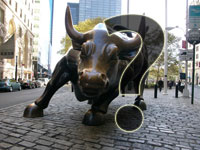In the late 1970s and early 1980s, the American economy was in crisis after years of stagflation. Mortgage rates were 17%, business loans carried 20% interest rates and productivity had collapsed. On April 21, 1980, Time magazine ran a cover story that asked the question: “Is Capitalism Working?” Today, the crisis that the American economic system faces is greater than that during the darkest days of stagflation. In this opinion piece, George M. Taber, former business editor of Time magazine and author of the 1980 cover story, asks and answers the same question — 29 years later.
The April 21, 1980, cover of Time magazine carried the stark headline: “Is Capitalism Working?” The American economy was in crisis after years of stagflation. The story recounted the ills: Mortgage rates were 17%, business loans carried 20% interest rates and productivity had collapsed. The article quoted Robert Lekachman, a left-leaning City University of New York economist, as saying, “The central economic fact of our day is the declining vitality and élan of capitalism and capitalists.” On the opposite side of the political spectrum, Chrysler Chairman Lee Iacocca was quoted as saying, “Free enterprise has gone to hell.”
I wrote that cover article, which set out the troubles facing capitalism in a crisis that shook the American economy to its roots. The 12-page story, twice the size of a normal cover piece at the time, outlined the history of capitalism and the case for it and against it. There was no doubt about my conclusion, and I still agree with the story’s final sentence: “For all its obvious blemishes and needed reforms, capitalism alone holds out the most creative and dynamic force that any civilization has ever discovered: the power of the free, ambitious individual.”
Today, the attacks on the American economic system are even greater than in the darkest days of stagflation, and even fewer people are now willing to stand up in defense of the economic philosophy that has its roots in Adam Smith’s Wealth of Nations, published in 1776.
Perhaps ironically, the period between the last and present crises of capitalism was a two-decade long golden age of capitalism. The U.S. enjoyed an unprecedented period of strong growth, minimal inflation, low unemployment and great innovation. During that time, many other countries also turned to freer economies. China in 1978 opened its state-controlled economy to a greater role for the private sector, while India took the same path starting in the mid-1980s. The collapse of the Soviet Union in the late 1980s led to freer economies throughout Eastern Europe.
Every country brings to capitalism its own culture and history, and the mix of state direction and private initiative varies from nation to nation. The American model of capitalism is different from the Japanese one, and the French or Russian ones are unique in their own way and similar to none of the others.
Schumpeter’s “Creative Destruction”
Stripped down to its core and at its best, American capitalism is ideologically close to the theories espoused by Joseph Schumpeter, an economist born in 1883 in what is now the Czech Republic and educated in Austria. He taught at Harvard from the 1920s to the 1940s. Schumpeter’s most important work was Capitalism, Socialism and Democracy, which was first published in 1942. The centerpiece of his thinking is the concept of “creative destruction,” a theory based on earlier work by the Russian Mikhail Bakunin as well as the Germans Friedrich Nietzsche and Werner Sombart. Schumpeter, though, popularized it.
Creative destruction means that old established companies under capitalism tend to lose their dynamism with time and atrophy under a layer of corporate bureaucracy and complacency. Then entrepreneurs, who usually have few links to the past, introduce bold and fresh ideas for new products, manufacturing techniques, or distribution and displace the old order. The process is often destructive, but also creative. This corporate lifecycle has repeated itself again and again in numerous fields: Ford Motor Company was innovative in the early 20th century, but Japanese auto companies passed Ford and other American auto makers in the 1970s; Sears Roebuck dominated U.S. retailing in the 1950s, but Wal-Mart has now eclipsed it; IBM in the 1960s reigned supreme over mainframe computers, yet Apple and Dell ushered in personal computers in the 1980s.
According to Schumpeter, innovation and entrepreneurs are the driving force of economic vitality and growth. The implication for American public policy is that government should foster policies — such as low capital gains taxes and few barriers to starting new companies — that encourage entrepreneurs to practice their craft.
In Northern California during the golden age of capitalism, venture capitalists and entrepreneurs combined to set off an explosion of innovation. Business people with great ideas found capital and started breakthrough companies. Naturally all of the new corporations did not succeed, but enough did that it was worth the risk. People such as Microsoft’s Bill Gates, a Harvard dropout, and Apple’s Steve Jobs, a Reed College dropout, were the epitome of creative destruction at work and helped start the information age. Both became billionaires along the way, and American society gained an inestimable benefit.
Silicon Valley also attracted ambitious foreigners such as Sequoia Capital’s Michael Moritz, a venture capitalist born in Wales and now another billionaire. I remember the first time I went to Silicon Valley in 1982 as the Time business editor. I was trying to figure out what made this the real Magic Kingdom and was astounded, among other things, by the large number of Asians and Europeans starting companies there. When I asked the founders why, they invariably told me it was because it was so much easier to start a company there than it would have been at home in South Korea or France. During the last decade, foreigners have started more than half of all new Silicon Valley companies. This gives the U.S. a valuable influx of talent that continues to benefit its economy.
The Weakest Link
The Achilles heel of capitalism, though, has always been the business cycle of boom and bust, or put another way, greed and fear. The problem has been growing more severe in recent times because of increasing national or international financial crises. A study by Barry Eichengreen of the University of California Berkeley and Michael Bordo of Rutgers found 139 such crises between 1973 and 1997, while only 39 between 1945 and 1973. This appears to be the unexpected, and perhaps inevitable, downside to the globalization of international capital markets, a development that on the whole has been good.
No doubt many mistakes were made in the U.S. during the past two decades. Financial regulation was too lax and was often not enforced. The relationship among government regulators, companies being watched, and legislative oversight committees was much too cozy. Salaries in the financial sector were shameful. It is now painfully obvious that bankers and other financial players had little or no understanding of the risk of investment derivatives that have been the centerpiece of the crisis. Perhaps the wisest statement to come out of the walkup to this mess was Warren Buffett’s warning that derivatives were financial weapons of mass destruction.
No government anywhere can just ignore what is now happening to the economy. The public demands action. Policymakers today, however, just as Roosevelt’s brain trust during the New Deal, are operating without a playbook. Lots of sometimes-contradictory stimulus measures are being tried, and some may do more harm than good. The basic problem with the U.S. economy at present is a lack of public confidence, and that will only be solved with a tincture of time. The experiences of the long Great Depression and Japan’s Lost Decade show that problems of confidence are solved only slowly. Well-intentioned, but unwise, changes in the nature of American capitalism could do damage that will be felt for decades.
Public officials searching for solutions are likely to look abroad at other free-economy models and try to adapt them in this country without sufficient appreciation for the historical and cultural differences between the countries. The most attractive model may be the French one. In the French version of capitalism, the commanding heights of both the public and private sector are in the hands of an elite group of officials who have attended the country’s Grandes écoles and often know each other very well. Why not let a nation’s economy be ruled by the best and brightest, while slightly reducing business freedom in order to tame the business cycle?
I worked in France as a journalist for three and a half years in the mid-1970s and saw its capitalism up close and personal. I have never seen a more talented group of top civil servants. Many are brilliant. The nation’s academic elite strives to get top civil service jobs and rarely goes into the private sector. That system, though, has been part of French culture and society for hundreds of years, going back at least to Jean-Baptiste Colbert, Louis XIV’s finance minister.
The situation in the U.S. is totally different. Few of America’s best students seek lifetime jobs in government, although many may go to Washington for a few years. You can’t run the French system in the U.S. without the French education and class infrastructure plus its mores. In the same way, it would be hard to glue America’s creative destruction onto French culture. I recall many conversations with young French people three decades ago when they complained about how difficult their government made it for them to start or run a private business. The country that coined the term entrepreneur actually does a bad job of fostering them.
As Washington policymakers search for ways to solve the current economic crisis, it is crucial that they keep in mind their country’s heritage and tradition. The American brand of capitalism rests on creative destruction, innovation and, ultimately, entrepreneurs. It is impossible to rebuild the superstructure of U.S. prosperity by destroying its foundation.



